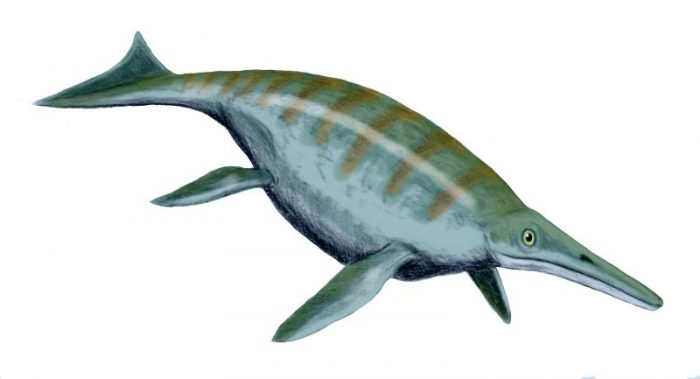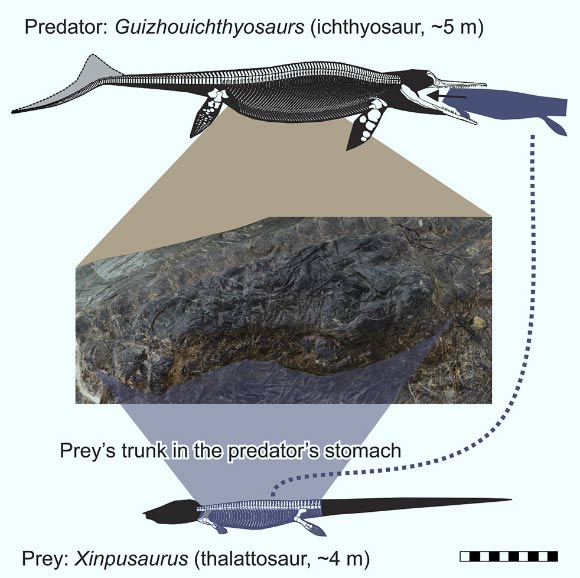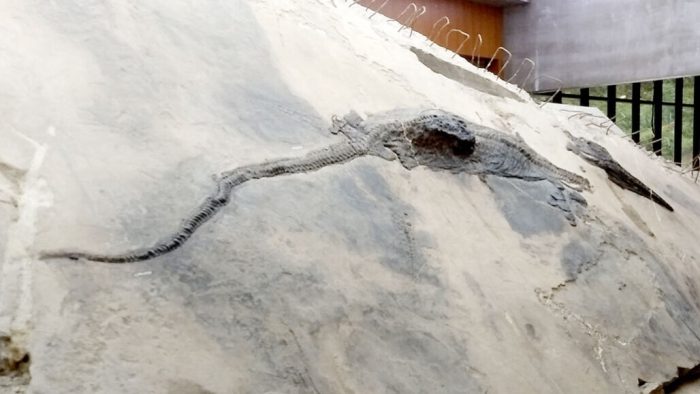With all the prehistoric specimens showcased around the globe, all of the dinosaurs, other ancient reptiles, fish, insects, and mammals on display in museums, it's easy to forget something.
Fossils are rare.
As in very rare. We even did a whole video about it! So when luck does arrive, and we're fortunate enough to get evidence of an animal that has been dead for hundreds of millions of years, paleontologists tend not to be picky. A couple of scattered bones is all we get? No problem, we'll take it! they say.
When experts get really lucky with a fossil, it's a cause for a huge celebration. Case in point? This ultra-rare find of a dead ichthyosaur with its last meal—a thalattosaur—preserved as a fossil inside!
Unusual prey

An illustration of an ichthyosaur. These animals were very common throughout most of the dinosaur age. (Nobu Tamura/Wikimedia Commons)
The reason this 240-million-year-old fossil inside a fossil is a big deal is because this one is so well preserved.
And large.
Ichthyosaurs were impressive dolphin-like reptiles. They were usually between 2 to 4 metres (7 to 13 feet) long, and this fossil was especially big: 4.8 metres, or nearly 16 feet! But thalattosaurs weren't exactly small either.
These prehistoric marine reptiles were like iguanas built for swimming. They could also be as large as 4 metres (13 feet). In other words, these were similar predators. Though these animals would've perhaps gotten into fights over food, researchers have long believed that ichthyosaurs and thalattosaurs would've usually been hunting the same prey, such as smaller fish or squid. Not each other.
So what happened?
Maybe that was too much food ...

This illustration shows the part of the thalattosaur that was eaten and where it was found inside the ichthyosaur. (© Da-Yong Jiang, et al, iScience)
The part of the thalattosaur that was inside the ichthyosaur's tummy was just its midsection. The head and tail were missing. And because it was so well-preserved, the ichthyosaur must have died very soon after eating it. (Otherwise, its stomach would've broken down its food.)
Interestingly, paleontologists also found another fossil about 25 metres (80 feet) away. A thalattosaur tail. Was this the tail of the same animal that the ichthyosaur ate? And did the ichthyosaur die simply because it ate way too much at once?
Researchers noticed that the ichthyosaur's neck vertebrae (neck bones) were damaged. This means that the animal's neck might have been broken trying to kill and swallow such large prey. Probably should've stuck to the squid buffet, Ichy!
Wider diet?
In the end, even fossils this well preserved and with so many clues still contain a lot of mystery. It's impossible to know exactly how the ichthyosaur died.
But what is clear is that ichthyosaurs did not only eat smaller prey. They sometimes fed on animals that were much closer to their own size—this behaviour is known as megapredation. The question researchers have before them is how rare was this type of meal? Was it a one-off that ichthyosaurs only turned to when desperate for food? Or a regular part of their diet?
Only the discovery of more fossils like this one can help answer that question. Here's hoping there's another fossil inside a fossil out there!
 The lump in the middle of this fossil is the remains of this ichthyosaur's final meal. (Ryosuke Motani)
The lump in the middle of this fossil is the remains of this ichthyosaur's final meal. (Ryosuke Motani)









